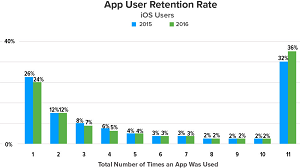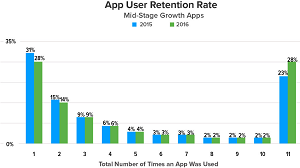News
Mobile Analytics Firm: 23 Percent of Users Abandon Apps After One Use
- By David Ramel
- June 1, 2016
According to mobile app analytics firm Localytics, mobile's importance is growing at a faster rate than the business innovation needed to keep pace, resulting in a "mobile engagement crisis" exemplified by poor user retention statistics.
"The data proves it," the company said in a blog post last week. "The percentage of users who abandon an app after one use is now 23 percent, a slight improvement from the 25 percent we saw in 2015. But clearly, with about one in four users still only using an app once, not enough has been done to match what consumers want and restore apps to the success of just a few years ago."
To address this mobile engagement crisis, the company updated its app user retention study -- which it has been conducting for five years -- with a focus on user retention and user abandonment.
"In the study, we also found that user retention recovered from 34 percent in 2015, a dip of 5 percentage points from the previous year, to reach 38 percent in 2016," the company said. "While this number is also an improvement, there is still work to be done in order to avoid churn and ultimately convert more users to loyal customers. Because even though 38 percent will return to an app 11 or more times, that means a whopping 62 percent will use an app less than 11 times. This is not a sustainable business model."
 [Click on image for larger view.]
iOS Users Perform Better in Retention (source: Localytics)
[Click on image for larger view.]
iOS Users Perform Better in Retention (source: Localytics)
The study is based on 120 billion monthly data points emanating from the Localytics mobile engagement platform, which encompasses 2.7 billion devices and 37,000 mobile and Web apps. Data was gathered from March 1, 2015 to April 30, 2016.
"We investigated a number of different areas that are impacting the changes in app user abandonment and retention and found that both iOS users and apps in the mid-stage of their growth drove the improvement this year," the company said.
Localytics said strong app retention by iOS users led to the aforementioned slight increase in overall statistics. Data showed that fewer iOS users only opened an app once (from 26 percent to 24 percent), while the percentage of iOS users who returned to an app 11 or more times increased (from 32 percent to 36 percent).
"One potential reason for this could be the advancements made to the overall app experience on iOS devices," the company said. "From multitasking to split screen to allowing notifications to be presented in chronological order versus grouping them by app, Apple has had a focus on improving the way consumers engage with their favorite apps."
 [Click on image for larger view.]
Mid-Stage Apps Also Perform Better in Retention (source: Localytics)
[Click on image for larger view.]
Mid-Stage Apps Also Perform Better in Retention (source: Localytics)
The company also investigated whether the size of apps influenced user retention, finding that mid-stage apps -- or those with 15,000 to 50,000 monthly active users (MAU) -- showed somewhat better numbers in terms of dropping apps after one use and returning to an app at least 11 times.
"This is most likely due to a stronger focus on engagement, as a means to drive retention in the typical app user lifecycle," Localytics explained. "Data shows that utilizing push notifications, in-app messages, e-mail or remarketing helps to grow the loyalty of their current users. In fact, we have seen user retention as high as 49 percent for users who have push notifications enabled. Once companies have established their ability to engage their users, they can focus on growing their user base -- propelling them to become a large, well-known app."
Along with push notifications boosting app retention, the company singled out in-app messaging as one powerful way to increase app engagement.
"Apps utilizing in-app messages see 46 percent of their users come back 11 or more times, while apps who do not incorporate an in-app strategy see that number drop to 36 percent," the company said. "In-app messages also have an effect early on in a user's lifecycle, as only 17 percent of users will only use an app once if they see an in-app message, while apps not utilizing in-app messages see 26 percent abandoning the app after one session.
"Since users do not have to opt-in to in-app messages, they can be a great way to onboard users to the app and then keep them engaged with the most useful features of the experience. If used effectively, and personalized to the user, in-app messages are a strong tool in an app's arsenal to keep users around."
About the Author
David Ramel is an editor and writer at Converge 360.